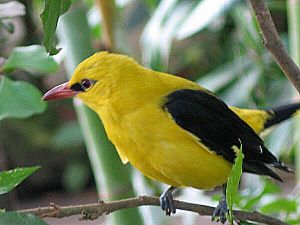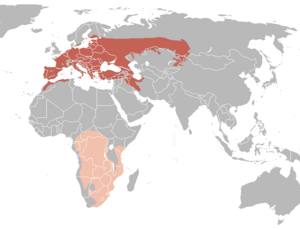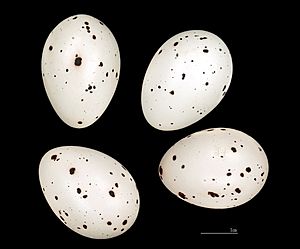Golden oriole facts for kids
Quick facts for kids Golden oriole |
|
|---|---|
 |
|
| Adult male | |
| Conservation status | |
| Scientific classification | |
| Kingdom: | |
| Class: | |
| Order: | |
| Family: | |
| Genus: | |
| Binomial name | |
| Oriolus oriolus (Linnaeus, 1758)
|
|
 |
|
The golden oriole (Oriolus oriolus) is a beautiful bird known for its bright colors. It is the only type of oriole that nests and raises its young in cooler parts of the Northern Hemisphere.
This bird belongs to the oriole family, which are passerine birds. Passerines are also called "perching birds" because they have feet made for gripping branches. Golden orioles spend their summers in Europe and western Asia. When winter comes, they fly all the way to central and southern Africa. This long journey is called migration.
Contents
What Does a Golden Oriole Look Like?
The male golden oriole is very striking. It has bright yellow feathers with black wings and a black eye stripe. But the female looks quite different! She is mostly a duller green color.
Even though the male is bright, these birds are quite shy. It can be hard to spot them among the yellow and green leaves in the treetops. When they fly, they look a bit like a thrush. They fly strongly and straight, with some gentle dips over longer distances.
The male Indian golden oriole looks a bit different. It has a black stripe that goes past its eye. Its beak is longer and a lighter red. It also has more yellow feathers.
Golden orioles have a call that sounds like a screech, similar to a jay. But their song is truly lovely! It sounds like a beautiful flute playing weela-wee-ooo or or-iii-ole. Once you hear it, you won't forget it.
Where Do Golden Orioles Live?
Golden orioles breed across a wide area, from western Europe and Scandinavia all the way east to China. They spend their winters in central and southern Africa.
These birds usually travel at night during their migration. However, they might fly during the day when they are heading north in the spring. During their autumn migration, they often stop in the Eastern Mediterranean region. Here, they eat a lot of fruit. Sometimes, people in this area see them as a bit of a nuisance because they eat so much fruit.
Golden orioles live in many different places. In Western Europe, they like open forests with broadleaf trees, small groups of trees, and forests near rivers. They also enjoy orchards and large gardens. In Eastern Europe, you might find them in larger, continuous forests, including mixed or pine forests. They usually avoid places without trees, but they might fly there to find food. In Africa, where they spend the winter, they live in woodlands that can be dry or humid. They also like tall forests, river forests, and areas where woodlands mix with savannas.
Golden Oriole Behavior and Life Cycle
Reproduction and Breeding
Golden orioles might not start having babies until they are 2 or 3 years old. The male birds usually arrive at the breeding areas a few days before the females.
Their nest is built high up in a tree, usually near the edge of the tree's leafy top. The nest is shaped like a deep cup and hangs from a horizontal fork of thin branches. The female builds the nest, but the male might help by bringing some materials. The nest is held together with strong plant fibers, sometimes as long as 40 centimeters. It is lined with soft grass, feathers, and wool to make it cozy.
A female golden oriole usually lays between 3 and 5 eggs. She lays one egg each day, early in the morning. The eggs are about 30.4 x 21.3 millimeters in size and weigh around 7.3 grams. They can be white, cream, or a very light pink. They also have black marks, which are sometimes grouped together at the wider end of the egg.
The female bird does most of the egg incubation, meaning she sits on them to keep them warm. But the male will sit on the eggs for short times so the female can go find food. The eggs hatch after about 16 to 17 days. Both parents feed the young birds, but the female mostly keeps them warm. The young birds are ready to fly, or fledge, after another 16 to 17 days. It is rare for a nest to be lost to predators because the parents bravely protect their babies.
The oldest golden oriole ever recorded lived for 10 years and 1 month. This male bird was tagged in 1986 and seen again in 1996.
What Do Golden Orioles Eat?
Golden orioles mostly eat insects and fruit. They use their beaks to pick insects out of small cracks and crevices.
See also
 In Spanish: Oropéndola europea para niños
In Spanish: Oropéndola europea para niños




